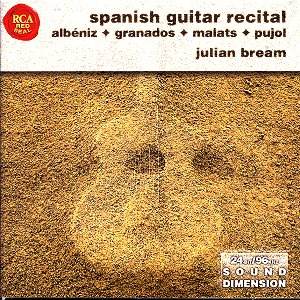 Composer: Isaac Albéniz, Enrique Granados, Joaquin Malats, Emilio Pujol
Composer: Isaac Albéniz, Enrique Granados, Joaquin Malats, Emilio Pujol
Works: Mallorca, Opus 202; Suite Española, Opus 47; Cordoba, Opus 323 No. 4; Dedicatoria; La Maja de Goya; Nadza Española No. 4; Valses Poèticos; Danza Española No. 5; Serenata; Tango Español; Guajira
Performers: Julian Bream, guitar
Recording: Recorded 1982-3, Wardour Chapel, Wiltshire
Label: BMG 74321 68016 2
Julian Bream’s guitar recital, featuring a selection of works by renowned Spanish composers, encapsulates the essence of the Spanish guitar repertoire with remarkable authenticity and depth. Composed in the late 19th and early 20th centuries, the pieces by Albéniz and Granados are steeped in nationalistic fervor and rich harmonic language, drawing from the folk traditions of Spain. Bream’s interpretations serve not only as a testament to his virtuosity but also as a bridge connecting the historical context of these works with contemporary listeners.
The recording successfully navigates the precarious balance required for guitar music, avoiding both excessive distance and overexposure of the instrument’s physicality. This engineering balance allows the listener to experience the full spectrum of Bream’s sound: the warm resonance of the guitar’s body coupled with the articulate clarity of each note. The Suite Española, with its sweeping melodic lines and intricate rhythms, is executed with a fluidity that captures the dance-like nature inherent in Albéniz’s composition. Bream’s nuanced phrasing in the “Asturias” movement, for instance, showcases his ability to imbue the music with a sense of urgency while maintaining a palpable sense of lyricism.
Granados’s Valses Poèticos emerges with a delicate tenderness that is both introspective and vibrant. Bream’s interpretation is characterized by a keen sensitivity to the subtleties of each waltz. His choices in tempo and dynamics breathe life into the music, ensuring that the pieces do not succumb to mere sentimentality but instead convey a robust emotional landscape. The Danza Española No. 5 exemplifies Bream’s deep understanding of the Spanish idiom, where his articulation of the syncopated rhythms and dynamic contrasts reveals the lively spirit of the dance.
Bream’s approach to the lesser-known works, such as Malats’s Serenata and Pujol’s Tango Español, is particularly commendable. He elevates these pieces from obscurity, revealing their intrinsic beauty and musicality. The Serenata, for instance, is imbued with a lyrical grace that highlights Bream’s mastery of tone production and his ability to create a sense of space within the music. The Tango Español, with its characteristic rhythmic vitality, is played with an infectious energy that invites the listener to appreciate Pujol’s melodic inventiveness.
The sound quality of this recording stands out, particularly in the context of guitar recordings from the early 1980s, where many suffered from either over-compression or excessive reverberation. The clarity achieved here allows for an intimate connection with the music, facilitating a deeper appreciation of Bream’s interpretative choices. When compared to other notable recordings of the repertoire, such as those by Andrés Segovia or Manuel Barrueco, Bream’s performance is distinct in its emotional depth and technical finesse, setting a high bar for subsequent interpretations.
This guitar recital is not merely a showcase of technical prowess; it is a profound exploration of the Spanish musical landscape, brought to life by one of its greatest contemporary interpreters. Bream’s ability to illuminate the nuances of each piece, combined with the superb quality of the recording, renders this an essential listening experience for both seasoned aficionados and newcomers alike. The artistry displayed in this performance solidifies its place as one of the finest guitar recitals of recent times.


